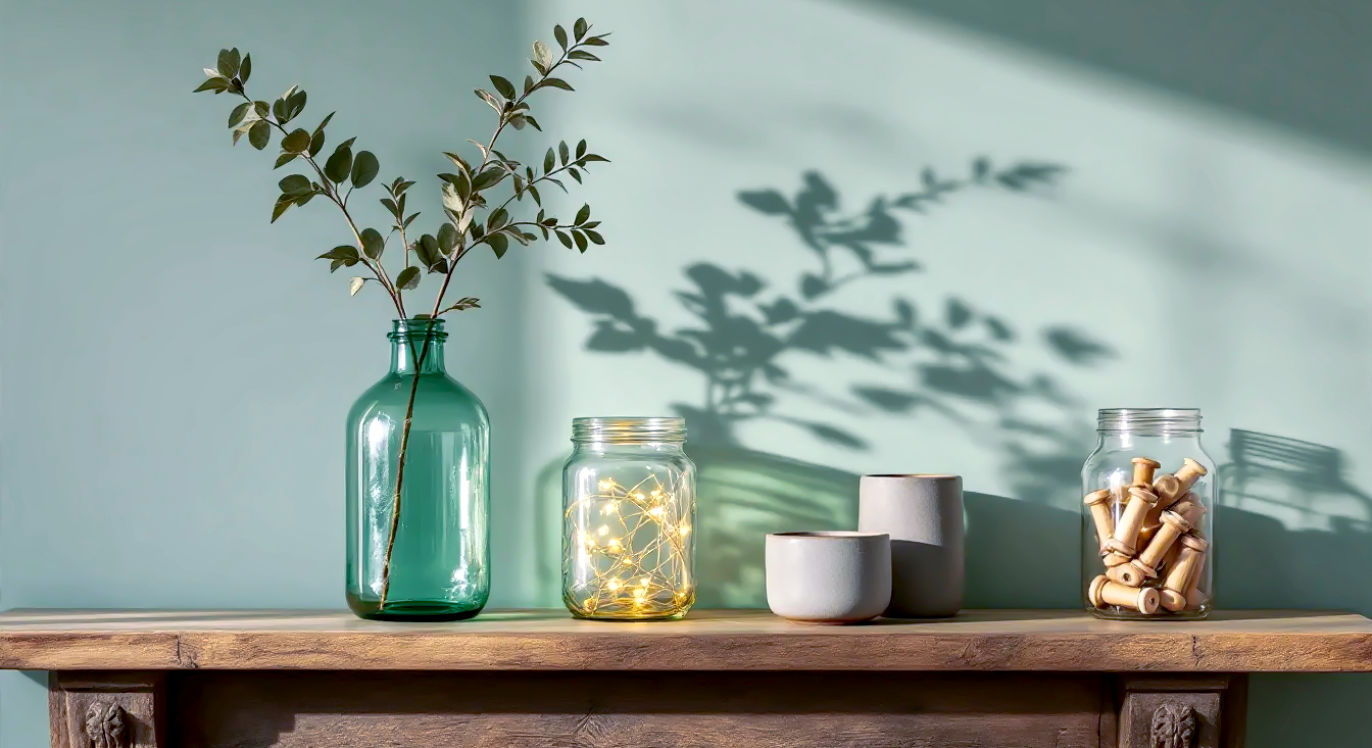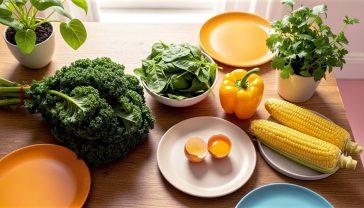From Kilner to Keepsake: The Guide to Enhancing Your Home with Decorative Jars
Transform your space with the humble jar. Our definitive guide covers everything from styling principles to seasonal ideas and upcycling tips for a perfect British home.

This post may contain affiliate links. If you make a purchase through these links, we may earn a commission at no additional cost to you.
Picture a classic British pantry on a crisp autumn afternoon. Shelves are lined with jewel-like jars of homemade strawberry jam and chunky marmalade. A big glass jar full of biscuits sits on the counter, and a collection of rustic ceramic pots holds wooden spoons and utensils. It’s a scene that feels cosy, timeless, and deeply familiar. But what if we told you that the humble jar—that simple glass or ceramic vessel—is one of the most powerful, versatile, and budget-friendly tools in your home decorating arsenal?
It’s true. Beyond storing pickles and pennies, jars are secret agents of style. They can bring order to chaos, create stunning focal points, tell a personal story, and add a splash of colour and texture to any room in the house. Whether you’re a minimalist who loves clean lines or a maximalist who adores curated collections, there’s a jar for that.
In this ultimate guide, we’re going to unlock the potential of these everyday objects. We’ll journey through their surprisingly fascinating history in Britain, explore the different types you can find, and learn the simple design rules that professionals use to make them look amazing. We’ll then take a tour through your home, room by room, uncovering practical and beautiful ideas for every space. From crafting a miniature garden in a jar to creating magical seasonal displays, you’ll discover how to transform your home with little more than a bit of glass and a dash of imagination. So, let’s get started.
A Potted History: The Jar’s Journey Through British Culture
You might not think a simple jar has much of a backstory, but its journey is woven into the very fabric of British life. It’s a tale of science, industry, and the simple, enduring need to keep things safe and sound.
From Roman Pottery to Victorian Apothecaries
The earliest jars in Britain were earthenware pots, brought over by the Romans to store everything from wine and olive oil to grain. For centuries, pottery was the go-to material. But the real game-changer was glass. While glassmaking existed, it wasn’t until the 17th century that British innovators like George Ravenscroft developed lead crystal, creating stronger, clearer glass.
Fast forward to the Victorian era, and the jar truly came into its own. Step into a recreation of a Victorian pharmacy, and you’ll see rows upon rows of elegant apothecary jars. With their ground-glass stoppers and often-beautiful Latin labels, they held potions, herbs, and mysterious concoctions. They were symbols of science and precision, and their classic shape still feels sophisticated today. At the same time, every sweet shop in the land had huge, gleaming glass jars filled with gobstoppers, sherbet lemons, and humbugs—a magical sight for any child.
The Kilner Jar: A British Revolution in Preservation
Before fridges, preserving food was a serious business. Making jams, chutneys, and pickles was essential for seeing a family through the winter. For years, people used simple jars sealed with wax or paper, but it was a bit hit-and-miss.
Then, in 1842, a Yorkshire-born glassmaker named John Kilner set up The Kilner Glass Company. While he didn’t invent the sealing jar himself, his company perfected it. The iconic Kilner Jar, with its two-part metal lid and rubber seal, created a vacuum that kept food fresh for months, even years. It was a revolution for the British kitchen. The design was so effective and popular that “Kilner jar” became a household name, much like “Hoover” for vacuum cleaners. It represents a spirit of British ingenuity, thrift, and self-sufficiency that’s still cherished today.
The Rise of the Decorative: Ginger Jars and Stately Homes
While the Kilner jar was a workhorse, other jars were purely for show. During the 18th and 19th centuries, trade with the Far East brought exotic goods to Britain. Spices like ginger were transported in beautiful blue-and-white porcelain jars. Once the ginger was gone, the jars were too lovely to throw away. These ginger jars, with their distinctive shape and intricate patterns, became coveted decorative items in the grand stately homes of Britain, often displayed on mantelpieces or in elegant cabinets. They were a sign of wealth and worldliness.
The Modern Revival: Sustainability and Style
Today, the jar is enjoying a massive comeback. In a world where we’re all trying to be more sustainable, upcycling a simple glass jam jar is a small act of rebellion against our throwaway culture. It’s a way to reduce waste while adding a personal touch to our homes. From trendy cafes serving drinks in Mason jars to stylish pantries organised with military precision, the jar is once again a hero of the home—proof that the most useful things can also be the most beautiful.
The Jar Directory: Know Your Apothecary from Your Kilner
Before you start styling, it helps to know what you’re working with. Jars come in all shapes and sizes, each with its own personality and best use. Here’s a rundown of the main players.
The Classic Glass Jar (Kilner, Mason, Le Parfait)
This is the everyday champion. Think of your standard jam jar or the sturdy clip-top jars used for preserving.
- What they look like: Usually clear glass, cylindrical or slightly square, with a screw-top or a wire-bale clip-top (the hinged lid with a rubber seal).
- Best for: Absolutely everything. They are the ultimate multi-tasker. Use them in the kitchen for storing dry goods, in the bathroom for cotton buds, or as simple vases for wildflowers. Their clear glass makes them perfect for showing off colourful contents.
- British Connection: The Kilner jar is a true British icon, invented and popularised right here.
The Elegant Apothecary Jar
These are the scientists of the jar world—classic, sophisticated, and a little bit formal.
- What they look like: Often made of fine, clear glass, they can be tall and thin or short and wide (sometimes called candy jars). Their defining feature is a separate, often decorative, ground-glass lid or stopper.
- Best for: Creating a stylish, organised look in the bathroom for things like bath salts, cotton wool balls, and soaps. They also look fantastic in a living room filled with decorative items like shells, corks, or even fairy lights.
- Top Tip: They aren’t airtight, so don’t use them for storing food that could go stale.
The Ornate Ginger Jar
The aristocrat of the jar family, the ginger jar brings a touch of worldly elegance to a room.
- What they look like: Made of ceramic or porcelain, they have a distinctive high-shouldered, rounded shape with a small opening and a domed lid. They are often decorated with intricate patterns, famously in blue and white.
- Best for: Making a statement. A single, large ginger jar can be a stunning focal point on a console table, sideboard, or mantelpiece. Smaller ones can be grouped together. Traditionally they are displayed with their lids on.
- Design Secret: Because they are opaque, what’s inside doesn’t matter. Their beauty is all on the surface.
The Rustic Ceramic or Earthenware Pot
These jars have a warm, earthy, and handmade feel, connecting your home to nature and tradition.
- What they look like: Made from clay, they can be glazed or unglazed (terracotta). They often have a simple, sturdy shape and come in earthy colours like brown, cream, grey, and green. Think of old stoneware pots for salt or butter.
- Best for: Kitchens and utility rooms. They’re perfect for holding utensils, as a pot for herbs, or just for adding a touch of rustic charm to a shelf. They add texture and warmth to a modern kitchen.
- Local Flavour: Look out for vintage ceramic jars from British potteries like Hornsea or Denby at car boot sales for a piece of local history.
The Nostalgic Sweet Jar
These bring a sense of fun, playfulness, and old-fashioned charm to any space.
- What they look like: Large, clear glass jars, often with angled sides to make it easy to see the contents, and a simple glass or plastic lid. They are designed to be tilted for easy access.
- Best for: More than just sweets! Use them in a home office for stationery, in a craft room for buttons or ribbons, or in a utility room for laundry pods. Their large size makes them great for practical storage.
The Grand Demijohn
Also known as a carboy, this is the gentle giant of the jar world.
- What they look like: Very large glass vessels, often with a bulbous body and a narrow neck. They were traditionally used for fermenting wine or cider. They come in beautiful shades of green, blue, or brown glass.
- Best for: A dramatic, standalone statement piece. Place one in an empty corner of a room, on a hearth, or in an entrance hall. Pop a single, dramatic branch or some tall pampas grass inside.
The Art of Jar Styling: Principles for a Perfect Display
So you’ve got your jars. Now what? You could just line them up, but to make them look truly special, it helps to know a few simple design tricks. Don’t worry, you don’t need a degree in interior design—these are easy rules that make a huge difference.
The Rule of Three: Your Secret Weapon
This is the oldest trick in the book for a reason. Our brains love things arranged in odd numbers, especially threes. An arrangement of three jars almost always looks more dynamic and visually appealing than two or four.
- How to do it: Group three jars together. They could be three of the same type or a mix. This simple trick instantly makes your display look purposeful and curated.
Play with Scale and Height
A display where everything is the same height can look a bit flat and boring. Creating variation is key to drawing the eye in.
- How to do it: When you group your three jars, choose ones of different heights: a tall one, a medium one, and a shorter one. This creates a pleasing visual “triangle.” If all your jars are the same height, you can stand one on a small stack of books or a wooden block to elevate it.
Texture, Colour, and Repetition
Creating a cohesive look is about finding a common thread. This could be the material, the colour, or the contents.
- Texture: Mix different materials to add interest. Try pairing a smooth glass apothecary jar with a rustic ceramic pot and a woven basket. The contrast is what makes it work.
- Colour: You can create a theme with colour. Group several blue and white ginger jars for a classic look, or fill clear glass jars with items of the same colour (e.g., white pebbles, green sea glass) for a modern, unified display.
- Repetition: Sometimes, more is more. A long line of identical jars, perfectly spaced on a shelf and filled with the same thing (like pasta or spices), can look incredibly powerful and organised. This works brilliantly in a kitchen.
The Power of the Filler: What to Put Inside
A jar is just a vessel; what you put inside brings it to life. Think beyond the obvious.
- Natural Elements: Shells, pebbles, sand, pinecones, dried flowers, moss, or seasonal branches.
- Colourful Items: Buttons, beads, marbles, sea glass, or even colourful spices like turmeric and paprika.
- Light Sources: Battery-powered fairy lights (micro-LEDs on a wire are best) or a simple candle (always be careful!).
- Practical Things (Made Beautiful): In the kitchen, layers of lentils, beans, and pasta look great. In the bathroom, colourful bath bombs or simple white cotton balls look clean and serene.
- Nothing at all: Sometimes, a beautifully shaped jar—like a green glass demijohn—is a sculpture in its own right and needs nothing inside.
Location, Location, Location: Finding the Right Spot
The final piece of the puzzle is placement. Think about the unused spaces in your home.
- Windowsills: Perfect for catching the light. Glass jars filled with water and single flower stems or coloured sea glass will glow beautifully.
- Mantelpieces and Shelves: The natural home for a curated display. Use the Rule of Three and vary the heights.
- Coffee Tables and Sideboards: Create a central vignette. Group jars on a tray to keep them feeling contained and deliberate.
- Unexpected Corners: An empty corner on the floor is the perfect spot for a large demijohn. A small stool with a single jar on it can liven up a dull space.
A Room-by-Room Guide to Jar Perfection
Now let’s put these principles into practice. Here are some simple, effective ideas for using jars in every part of your home.
The Kitchen: A Hub of Stylish Utility
The kitchen is the jar’s natural habitat. Here, they can be both stunningly beautiful and incredibly practical.
Pantry Organisation
This is the classic use. Decanting dry goods like flour, sugar, pasta, and cereal into clear glass jars doesn’t just look amazing; it’s practical too. You can see at a glance what you have, and airtight jars keep food fresher for longer.
- Pro Tip: Choose jars that are the same style but different sizes for a uniform look. A simple brown paper tag tied on with string makes for a charming, rustic label.
Countertop Vignettes
Your worktop is prime real estate. Use it to keep essentials handy in a stylish way.
- The Utensil Pot: A heavy ceramic or stoneware jar is perfect for holding wooden spoons, whisks, and spatulas next to the hob.
- The Tea & Coffee Station: Use smaller, matching jars for your tea bags, coffee beans, and sugar. Arrange them on a small wooden tray to create a neat, dedicated zone.
Herb Gardens in a Jar
You don’t need a garden to grow your own fresh herbs. A row of simple glass jars on a sunny windowsill makes a perfect indoor herb garden.
- How to do it: Add a layer of small pebbles to the bottom of each jar for drainage, then top with potting soil and your herb seedling (parsley, mint, and basil work well). They look great and taste even better.
The Living Room: Creating Cosy Corners and Focal Points
In the living room, jars move from being practical to being purely decorative. This is where you can get really creative.
Mantelpiece Magic
The mantelpiece is a natural stage for your best pieces.
- Symmetrical Style: Place two identical large jars at either end of the mantelpiece for a formal, balanced look. Ginger jars are perfect for this.
- Asymmetrical Art: Create a more relaxed feel by grouping three jars of different shapes and sizes to one side. Fill one with fairy lights, one with dried eucalyptus, and leave one empty.
Coffee Table Centrepieces
A coffee table can feel a bit empty without a centrepiece.
- The Jar on a Tray: A single, wide-mouthed jar on a tray can become a seasonal display. Fill it with mini baubles at Christmas, tiny painted eggs at Easter, or shells in the summer. It’s an easy way to refresh your décor.
Shelf Styling
Use jars to break up rows of books on a bookshelf. Slot a small jar filled with colourful beads or a trailing plant in between volumes to add depth and interest.
The Bathroom: A Sanctuary of Serene Storage
The bathroom can easily get cluttered with plastic bottles and packaging. Jars are the perfect solution for creating a calm, spa-like feel.
Taming the Toiletries
Use a collection of apothecary jars or simple glass jars to store everyday essentials.
- What to store: Cotton wool balls, cotton buds, bath salts, bath bombs, and small bars of soap all look fantastic when taken out of their packaging and displayed in glass jars. It turns the mundane into something beautiful.
Creating a Spa-like Vibe
A single jar can set a tranquil mood.
- The Scent Jar: Fill a jar with Epsom salts mixed with a few drops of lavender essential oil. It will look serene and gently scent the room.
- The Flower Jar: A simple jam jar with a single, beautiful flower head floating in water is an elegant and minimalist touch for the side of the sink or bath.
The Bedroom: Tranquil Touches and Personal Treasures
Jars in the bedroom should be personal and calming.
- Bedside Beauty: Use a small, pretty jar on your bedside table to hold your watch, rings, and earrings overnight.
- Memory Jars: A large glass jar can become a home for personal keepsakes: ticket stubs, photos, shells from a favourite beach, or corks from special occasions. It’s a living, evolving piece of personal art.
The Garden and Beyond: Bringing the Outside In (and Vice Versa)
Don’t forget the outdoors! Jars are brilliant for blurring the lines between your home and garden.
- The Potting Shed: Organise seeds, plant labels, and bits of string in a row of sturdy jars in your shed or greenhouse.
- Outdoor Lanterns: Hang jam jars from tree branches with wire, pop a tea light in each one, and you have instant, magical lighting for a summer evening party. (Use battery-powered tea lights for safety).
Get Crafty: Simple DIY Jar Projects to Transform Your Home
One of the best things about jars is that they are a blank canvas. With a few simple supplies, you can turn a plain jar into something unique. Here are a few easy projects to get you started.
Project 1: The Miniature Terrarium – A World in a Jar
A terrarium is a self-contained miniature garden. They look incredibly impressive, but they’re surprisingly easy to make.
- You’ll need: A large, clean glass jar with a wide opening, small pebbles, activated charcoal (from a pet shop), potting soil, and small, moisture-loving plants like ferns, moss, or fittonia.
- Step 1: Add a 1-inch layer of pebbles for drainage.
- Step 2: Add a thin (half-inch) layer of charcoal. This keeps the soil fresh.
- Step 3: Add a deep layer of potting soil.
- Step 4: Gently plant your small plants inside, using a stick or the end of a spoon to arrange them.
- Step 5: Give it a light misting of water, and you’re done! Keep it in a spot with indirect light.
Project 2: The Easiest Painted Jars (No Artistic Skill Needed!)
Painting jars can give them a whole new lease of life and let you match them perfectly to your décor.
- You’ll need: A clean glass jar, chalk paint (which sticks to glass really well), and a paintbrush.
- The Trick: Paint the inside of the jar, not the outside!
- Step 1: Pour a generous amount of chalk paint into the jar.
- Step 2: Swirl the paint around until the entire inner surface is coated.
- Step 3: Tip the jar upside down on some newspaper and let all the excess paint drip out.
- Step 4: Leave it to dry. You’ll be left with a jar that has a perfect, smooth colour on the inside while the outside remains glossy and reflective. They make brilliant vases.
Project 3: The Magical Fairy Light Lantern
This is the simplest project in the world and has the most magical effect.
- You’ll need: A clean jar (any shape will do) and a string of battery-powered micro-LED fairy lights on a wire.
- Step 1: Gently feed the string of lights into the jar, arranging it loosely.
- Step 2: Tuck the small battery pack just inside the neck of the jar or hide it behind.
- Step 3: Switch on. Instant atmosphere! These look wonderful grouped on a mantelpiece or used as a table centrepiece.
Project 4: The Memory Jar – Capturing Moments in Time
A lovely family tradition or a personal project.
- You’ll need: A large, clean jar and small slips of paper.
- How it works: At the start of the year, place the empty jar somewhere prominent. Throughout the year, whenever something good happens—a funny moment, a small achievement, a happy memory—write it on a slip of paper, date it, and pop it in the jar. On New Year’s Eve, tip out the jar and read through all the wonderful moments from the past year.
A Year in Jars: Seasonal Styling Ideas for Every Occasion
Jars are the perfect way to subtly nod to the changing seasons in your home décor. It’s an easy and affordable way to keep your space feeling fresh.
Spring: Fresh Starts and New Growth
- Miniature Bulbs: Plant small bulbs like grape hyacinths or crocuses in a jar with some soil and moss.
- Easter Display: Fill a large jar with speckled faux eggs, feathers, and pussy willow branches.
- Simple Stems: A collection of jam jars, each holding a single daffodil or tulip, looks effortlessly cheerful on a windowsill.
Summer: Coastal Vibes and Sunshine Hues
- Beach in a Jar: Layer sand, pebbles, and shells collected from a British beach holiday.
- Pressed Flowers: Press wildflowers from the garden and trap them between two jars (one fitting snugly inside the other) for a beautiful, translucent effect.
- Lemon Water: A large drink dispenser jar filled with water, sliced lemons, and mint looks great at a summer BBQ and tastes refreshing too.
Autumn: Cosy Comforts and Golden Tones
- Nature’s Treasures: Fill jars with acorns, conkers, pinecones, and colourful autumn leaves.
- Warm Glow: Wrap the outside of a jar with autumn leaves, securing them with twine, and pop a battery tea light inside for a warm, leafy glow.
- Harvest Display: Layer dried beans, lentils, and split peas to create stripes of earthy colours.
Winter: Festive Cheer and Frosty Charm
- Winter Wonderland: Create a snow scene in a jar. Put a layer of coarse salt or faux snow at the bottom and add a small model house, animal, or bottle-brush Christmas tree.
- Floating Candles: Fill a jar with water, some cranberries, and a sprig of fir, then float a tea light on top for a simple, elegant Christmas centrepiece.
- Edible Gifts: Layer the dry ingredients for cookies or hot chocolate in a jar, add a recipe tag, and you have a thoughtful, homemade Christmas present.
The Practical Side: Sourcing, Cleaning, and Caring for Your Jars
To become a true jar enthusiast, you need a few final bits of practical know-how.
Where to Find the Best Jars (Without Breaking the Bank)
- Your Own Recycling Bin: The best place to start! Wash out your jam, coffee, and sauce jars. It’s free and sustainable.
- Charity Shops and Car Boot Sales: These are treasure troves for unique and vintage jars, from old Kilner jars to interesting ceramic pots, often for just a few pennies.
- Discount Home Stores: Shops like The Range, B&M, and Home Bargains often have a great selection of new decorative jars at very low prices.
- Catering Suppliers: If you want a large number of matching jars for a big project (like a pantry makeover), catering supply websites can be very cost-effective.
The Ultimate Guide to Cleaning and De-labelling
Getting a jar perfectly clean and free of its sticky label is the first step to making it beautiful.
- Step 1: The Soak. Soak the jar in hot, soapy water for about 10 minutes. This will often loosen the label enough to peel it off easily.
- Step 2: The Stubborn Residue. For the sticky glue that gets left behind, the magic ingredient is oil. Any cooking oil will do. Rub it over the sticky patch with a paper towel, and the glue will break down and wipe away.
- Step 3: The Final Clean. Give the jar a final wash in hot, soapy water to remove any oiliness, or pop it in the dishwasher. To get rid of any lingering smells (like pickle or garlic), a rinse with a mixture of water and bicarbonate of soda or white vinegar usually does the trick.
Common Pitfalls to Avoid (And How to Fix Them)
- The Clutter Trap: It’s easy to go from a curated collection to just… a load of old jars. The fix: Be intentional. Group them, use trays to contain them, and stick to the “less is more” principle unless you’re creating a deliberate, repetitive display.
- The Dusty Display: An open jar can be a dust magnet. The fix: Choose fillers that are easy to clean (like pebbles or sea glass that can be rinsed) or simply put lids on your jars. Give them a quick wipe as part of your regular dusting routine.
- The Safety Slip-up: Never leave a real candle burning in a jar unattended, especially if it’s a narrow jar where heat can build up. The fix: Use battery-powered LED candles. They give the same cosy flicker with zero risk.
Conclusion: The Enduring Charm of a Simple Glass Jar
From its practical beginnings in a Yorkshire glass factory to its place on the most stylish modern mantelpiece, the humble jar has proven itself to be a true hero of the British home. It’s a symbol of our love for preserving, our knack for making do and mending, and our quiet creativity.
Using jars to enhance your home isn’t about spending a lot of money or following a fleeting trend. It’s about seeing the potential in the everyday. It’s about sustainability, personality, and the simple joy of creating something beautiful with your own hands. So next time you finish a jar of jam, pause before you pop it in the recycling. Look at it again. It might not just be a jar. It might be a vase, a lantern, a tiny garden, or the start of your next great display. All it needs is a little bit of your imagination.
Further Reading:






